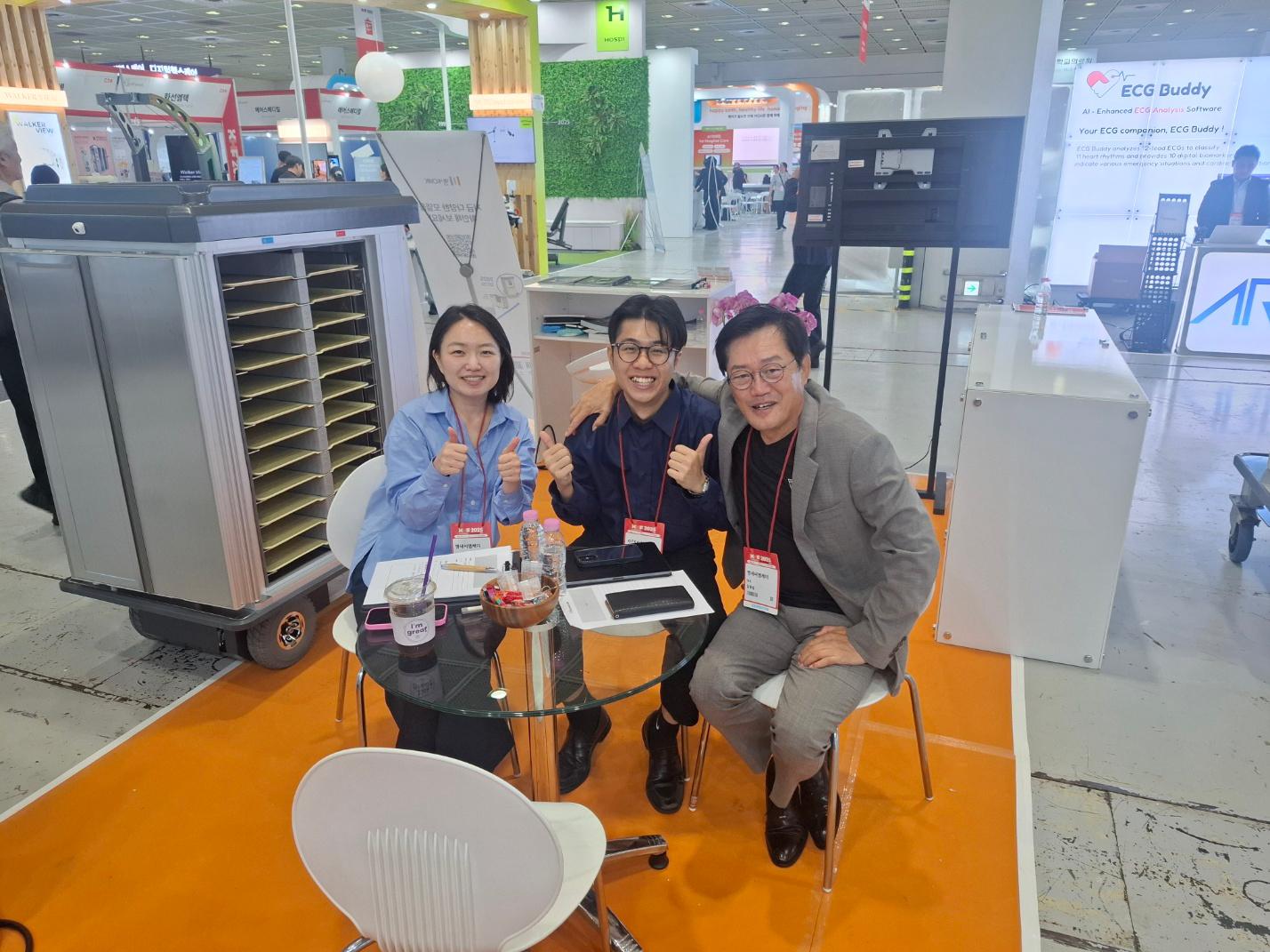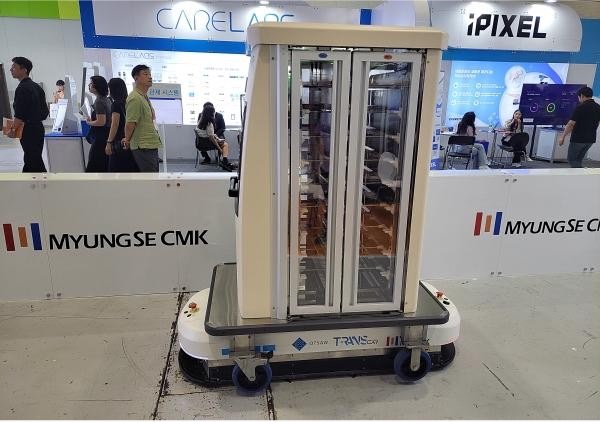
Transcar, the Logistics Robot, is a Quiet Worker Responsible for 80% of Hospital Logistics
Healthcare is a labor-intensive service industry. This is because a large workforce must manually move vast quantities of supplies, including patient meals, medicines, supplies, specimens, laundry, and waste within the hospital. Statistics show that the average daily distance traveled by nurses responsible for transporting medications, injections, blood, and specimens is equivalent to walking five soccer fields.
For this reason, hospital logistics transport robots are being evaluated as a smart healthcare solution that enhances the efficiency and economic viability of hospital operations by performing non-clinical, repetitive logistics tasks in place of nurses and medical support staff.
Furthermore, they go beyond simple human resource replacement and establish a foundation for “automation and datafication” of hospital logistics, accelerating digital transformation and the transition to smart hospitals.
Myungse CMK (CEO Jong-seop Kim), a company specializing in hospital-style distribution carts, unveiled its hospital logistics transport robot, TransCar, at the ’12th International Hospital & Health Tech Expo’ (KHF 2025), which opened at COEX in Seoul on the 17th. Developed by Singaporean robotics company OTSAW, TransCar is an Automated Guided Vehicle (AGV) that has been adopted by over 90% of public hospitals in Singapore as well as about 20 countries around the world. It autonomously transports trolleys weighing up to 500 kg.
At the KHF 2025 event, Rapportian met with Jonathan Ng, Global Business Development Manager at OTSAW, to learn about the utility of hospital logistics transport robots, focusing on the case of Singapore.
The Singaporean company OTSAW may be somewhat unfamiliar to Korean medical professionals, including doctors and nurses. What kind of company is it?
Briefly, OTSAW is a robotics company founded in Silicon Valley in 2015 and currently headquartered in Singapore. In the healthcare sector, it’s particularly well-known for its autonomous hospital logistics transport robot, “TransCar.” TransCar reliably and autonomously transports heavy items like patient meals, bedding, laundry, waste, and other items 24/7, 365 days a year, and is currently used in over 50 hospitals in 20 countries.
What are the main features and advantages of TransCar?
There’s a Korean expression, “Staying true to the basics.” TransCar is a hospital logistics transport robot that sticks to the basics. Its focus on the fundamentals of hospital logistics and its excellence in execution has earned it the trust of hospitals in over 20 countries. TransCar, in particular, empowers hospital staff to focus more on patient care. It transports up to 500 kg of patient food, bedding, medical supplies, and waste between departments and floors, safely navigating between people using elevators. Its accurate and stable delivery according to pre-determined routes and schedules ensures the reliability and timeliness of patient food delivery, sterilized supplies, and pharmaceutical supplies.
Moreover, the system can be easily reprogrammed and expanded during hospital remodeling or expansion. TransCar, as a “quiet worker,” is always on the move, tireless, and ready to perform its duties when needed. Furthermore, its opportunistic charging system allows it to automatically recharge during periods of inactivity, enabling up to eight hours of continuous operation. The fact that it has been adopted by hospitals in over 20 countries around the world underscores TransCar’s commitment to the fundamentals of hospital logistics.

What are the differentiated features and competitiveness of TransCar compared to Aethon's TUG, Swisslog Healthcare's NaviBot, and Relay?
Each hospital logistics transport robot has its own unique characteristics. OTSAW focused on perfecting the fundamentals of the TransCar for hospital logistics. The TransCar can autonomously transport trolleys weighing up to 500 kg, 365 days a year, and its durability allows it to operate for over 10 years. Some hospitals even use it for over 15 years.
Most heavy-duty logistics transport robots are forward-driving, requiring them to rotate in place when changing direction. This process, repeated thousands of times, rapidly wears out the floor and wheels. In contrast, TransCar’s bidirectional design, capable of both forward and reverse, allows for changes in space as small as 1.8 meters, reducing wear and tear. Just as soccer players consistently hone their fundamental “running” skills to maintain long-term performance, TransCar, by diligently mastering the fundamentals of logistics, ensures smooth hospital operations and a long lifespan.
OTSAW designed the TransCar to be optimized for actual hospital operations, leveraging its deep understanding of the Asian healthcare environment and the leadership of its Singaporean CEO.
In many medical institutions in Korea, nurses and other personnel still perform repetitive, labor-intensive tasks, such as transporting medications, blood, and specimens to their respective locations, such as laboratories or diagnostic medicine departments. In this reality, logistics transport robots can help medical staff focus more on patient care and treatment, while also facilitating more efficient staffing. What benefits do hospital logistics transport robots provide to medical institutions?
OTSAW has been working in the healthcare industry for a long time and has closely observed medical trends around the world. In many hospitals, especially in advanced healthcare systems like Korea, heavy transport such as patient meals, bedding, medical supplies, and waste accounts for approximately 80% of total logistics tasks. The remaining 20% involves transporting medicines, documents, and small specimens, which are relatively easy to automate. This explains why many small robots focus on this area.
Meanwhile, the TransCar transports cargo weighing up to 500 kg, moves between departments or floors, and operates autonomously and safely 24/7. This solves the remaining 80% of the labor- intensive and resource-intensive tasks. This allows hospitals to redeploy staff to patient care, reduce fatigue, and achieve true efficiency.
Of course, achieving ROI (return on investment) in a short period of time is no easy feat. However, this is only achieved by solving the most challenging problems. Automating hospital logistics through logistics transport robots directly improves operational performance by reducing costs, time, and labor. OTSAW has both small transport robots and large logistics robots like TransCar, supporting complex operations tailored to the specific needs of hospitals. We are confident that true ROI is achieved by automating heavy logistics transport within hospitals.
TransCar is understood to have been implemented in over 90% of Singapore's public hospitals. What are the achievements, such as reduced nurses' work hours, since its introduction in these hospitals?
First, looking at financial performance, Singapore has high labor costs and recruiting relevant personnel is challenging. Furthermore, recruitment, training, and turnover management costs add up.
TransCar has shown long-term cost savings, and the savings have been repurposed for hospital operations.
Operationally, delivery reliability and punctuality have been secured, and schedules have been maintained stably, significantly improving hospital logistics efficiency. In particular, medical staff no longer have to endure the difficult task of pushing heavy carts. Furthermore, hospitals that have adopted TransCar are recognized by patients as innovative institutions, and some have even won awards for productivity and innovation following implementation.
A single TransCar can support the work of up to three staff members, allowing them to be reassigned to more meaningful roles or to oversee robot operations. With hospitals typically designed to operate for 50 years or more, logistics transport robots like TransCar are a future-proof strategy that ensures long-term operational stability.

Singapore
OTSAW Digital Pte Ltd
OTSAW Swisslog Healthcare Robotics Pte Ltd
10 Tampines North Drive 4, #01-03
Singapore 528553
United States
OTSAW Digital Inc
Germany
OTSAW Swisslog Healthcare Robotics GmbH
© OTSAW Digital Pte Ltd
Privacy Policy
